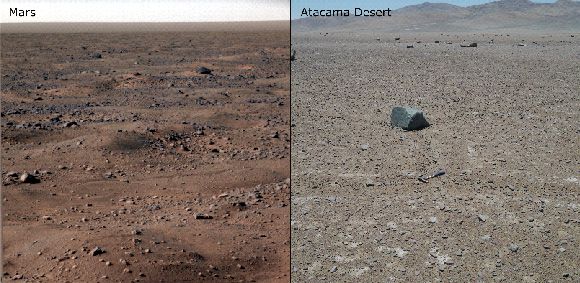A Temporary Habitat in the Driest Place on Earth
Martian microbes may rely on the same survival strategies as desert dwellers on our own planet.
/https://tf-cmsv2-smithsonianmag-media.s3.amazonaws.com/filer/75/7f/757ff21b-7551-4859-85f9-d75e2aa3ed17/dirk_atacama.jpg)
The Atacama Desert in South America is one of the least hospitable places on Earth, and biologists have long wondered whether microbial DNA found in the area’s driest core derives from microorganisms blown in by the wind—which are now dying slowly—or whether there might still be microbial activity in that harsh environment.
The question seems to be settled now. In a paper published today in the Proceedings of the National Academy of Sciences, an international group of colleagues and I report finding microbial activity based on measured metabolism (enzyme activity, ATP, and metabolic by-products), along with microorganisms currently undergoing reproduction in the hyperarid core of the Atacama Desert in Chile. This means the area is still a habitat, if only a temporary one.
Our research team collected a data set of unprecedented breadth over the course of three field sampling campaigns conducted in the last three years. It included the analysis of bacteria, archaea, fungi, viruses, and many biochemical and geochemical indicators. The first field campaign was in April 2015, shortly after one of the rare rainfall events in the Atacama, which provided sufficient moisture to activate microorganisms that had been dormant up to that point.

Our new findings have important repercussions for possible life on Mars. That planet used to be much wetter than it is now, but even today there are occasional events that could provide moisture to dormant microorganisms. Water is present on Mars as thin films on the surface of minerals, as well as what appear to be salty water flows on the Martian surface, and even occasional nightly snowfall events. As in the driest areas of the Atacama, any microbes on Mars could re-awaken when they came into contact with sufficient moisture. In that case, the planet may not be as lifeless as we once thought.
/https://tf-cmsv2-smithsonianmag-media.s3.amazonaws.com/accounts/headshot/Dirk-Schulze-Makuch-headshot.jpg)
/https://tf-cmsv2-smithsonianmag-media.s3.amazonaws.com/accounts/headshot/Dirk-Schulze-Makuch-headshot.jpg)